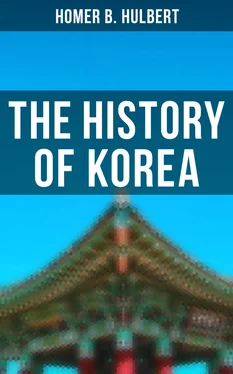With the end of Queen Söng-man’s reign affairs in the peninsula began to focus toward that crisis which Ko-gu-ryŭ and Păk-je had so long been preparing for themselves. In 655 a new combination was effected and one that would have made Sil-la’s horizon very dark had she not been sure of Imperial help. Her two neighbors formed a league against her, and of course the Mal-gal tribes sided with Ko-gu-ryŭ in this new venture. Păk-je and Ko-gu-ryŭ were drawn together by their mutual fear of Sil-la and soon the allied armies were marching on Sil-la’s borders. At the first onslaught thirty-three of Sil-la’s border forts passed into the hands of the allies. It was now China’s last chance to give aid to the most faithful of her Korean vassals, for otherwise she would surely have fallen before this combination. A swift messenger was sent imploring the Emperor for aid and stating that if it was not granted Sil-la would be swallowed up. The Emperor had no intention of letting Sil-la be dismembered and without a day’s delay troops were despatched into Liao-tung under Generals Chŭng Myŭng-jin and So Chöng-bang. Many of Ko-gu-ryŭ’s fortresses beyond the Yalu River were soon in the possession of China. This was successful in diverting Ko-gu-ryŭ’s attention from Sil-la, but Păk-je continued the fight with her. The advantage lay now with one side and now with the other. The court of Păk-je was utterly corrupt and except for a small army in the field under almost irresponsible leadership, she was weak indeed.
Now it happened that a Sil-la man named Cho Mi-gon had been taken captive and carried to Păk-je where he was employed in the household of the Prime Minister. One day he made his escape and found his way across the border into his native country, but there meeting one of the Sil-la generals he was induced to go back and see what he could do in the Păk-je capital towards facilitating an invasion on the part of his countrymen. He returned and after sounding the Prime Minister found him ready to sell his country if there was anything to be made out of it. It is said that here began the downfall of Păk-je. The king of Păk-je was utterly incompetent and corrupt. One of his best councillors was thrown into prison and starved to death for rebuking him ofhis excesses. But even while this faithful man was dying he sent a message to the king saying “Do not fail to place a strong garrison at ‘Charcoal Pass’ and at Păk River.” These were the two strategic points of Păk-je’s defenses; if they were guarded well, surprise was impossible. From that time affairs in Păk-je went from bad to worse. China kept Ko-gu-ryŭ busy in the north and nothing of consequence was gained by either side in the south until finally in 659 another Sil-la envoy made his appearance in the Emperor’s court. At last the great desire of Sil-la was accomplished. The Emperor ordered Gen. So Chöng-bang to take 130,000 men by boat to the shores of Păk-je and there coöperate with a Sil-la army in the utter subjugation of Păk-je. The Sil-la army went into camp at Nam-ch’ŭn and received word from the Chinese general to meet him at the Păk-je capital in the seventh moon.
Tradition says that the doom impending over Păk-je was shadowed forth in advance by many omens and signs. Frogs, it is said, grew like leaves on the trees and if anyone killed one of them he instantly fell dead. Among the mountains black clouds met and fought one another. The form of an animal, half dog and half lion, was seen in the sky approaching the palace and uttering terrible bellowings and roarings. Dogs congregated in the streets and howled. Imps of awful shape came into the palace and cried “Păk-je is fallen, Păk-je is fallen,” and disappeared in the ground. Digging there the king found a tortoise on whose back were writtenthe words “Păk-je is at full moon; Sil-la is at half moon.” The diviners were called upon to interpret this. “It means that Sil-la is in the ascendant while Păk-je is full and about to wane.” The king ordered their heads off, and called in another company of diviners. These said that it meant that Sil-la was half waned while Păk-je was at her zenith. Somewhat mollifiedby this, the king called a grand council of war. The advice given was of the most conflicting nature. Some said the Chinese must be attacked first; otherssaid the Sil-la forces must be attended to first. A celebrated general who had been banished was sent for and his advice was the same as that of the famous statesman whom the king had starved in prison. “You must guard the ‘Charcoal Pass’ and the Pak River.” But the majority of the courtiers said that the Chinese had better be allowed to land before they were attacked and that the Sil-la army should be allowed to come in part through the pass before being opposed. This latter point was decided for them, for when the Păk-je troops approached the pass they found that the Sil-la army was already streaming through, and at its head was the famous Gen. Kim Yu-sin. When the battle was joined the Păk-je forces held their ground and fought manfully; but victory perched upon the banners of Sil-la and when the battle was done nothing lay between the Sil-la forces and the capital of Păk-je, the place of rendezvous. It is said that Gen. Ke-băk the leader of the Păk-je forces killed all his family before starting out on this expedition, fearing lest the thought of them might make him waver. He fell in the battle.
The capital of Păk-je was situated on the site of the present town of Sa-ch’ŭn. When the Sil-la warriors approached it the king fled to the town now known as Kong-ju. He left all the palace women behind and they, knowing what their fate would be at the hands of the Sil-la soldiery, went together to a beetling precipice which overhangs the harbor of Tă-wang and cast themselves from its summit into the water beneath. That precipice is famed in Korean song and story and is called by the exquisitely poetical name Nak-wha-am “Precipice of the Falling Flowers.” The victors forced the gates of the capital and seized the person of the Prince, the king’s second son, who had been left behind. A few days later the King and the Crown Prince came back from their place of hiding and voluntarily gave themselves up.
The allies had now met as they had agreedand Păk-je was at their mercy. The Chinese general said that the Emperor had given him full authority to settle the matter and that China would take half the territory and Sil-la might have the other half. This was indeed a generous proposal on the part of China but the Sil-la commander replied that Sil-la wanted none of the Păk-je territory but only sought revenge for the wrongs that Păk-je had heaped upon her. At the feast that night the king of Păk-je was made to pour the wine for the victors and in this act of abject humiliation Sil-la had her desire for revenge fully satisfied. When the Chinese generals went back to China to announce these events they took with them the unthroned King of Păk-je together with his four sons, eighty-eight of the highest officials and 12,807 of the people.
It was in 660 that Păk-je fell. She survived for 678 years and during that time thirty kings had sat upon her throne. A singular discrepancy occurs here in the records. They affirm that the whole period of Păk-je rule covered a lapse of678 years; but they also say that Păk-je was founded in the third year of Emperor Ch’eng-ti of China. That would have been in 29 B.C. making the whole dynasty689 years. The vast burden of proof favors the belief that Păk-je was founded in 16 B.C. and that her whole lease of life was 678 years.
As Sil-la had declined to share in the dismemberment of Păk-je, China proceeded to divide it into provinces for administrative purposes. There were five of these, Ung-jin, Tong-myŭng, Keum-ryŭn, Tŭk-an. The central government was at Sa-ja the former capital of Păk-je. The separate provinces were put under the control of prefects selected from among the people. The country was of course in a very unsettled state; disaffectionshowed itself on every side and disturbances were frequent. A remnant of the Păk-je army took its stand among the mountains, fortified its position and bid defiance to the new government. These malcontents found strong sympathisers at the capital and in the country towns far and wide. The Chinese governor, Yu In-wŭn, found the task of government no easy one. But still Sil-la stood ready to aid and soon a Sil-la army crossed the border and attacked the fortress of I-rye where the rebels were intrenched. Taking this by assault they advanced toward the mountain fortress already mentioned, crossed the “Chicken Ford,” crumpled up the line of rebel intrenchments and lifted a heavy load from the governor’s shoulders.
Читать дальше









